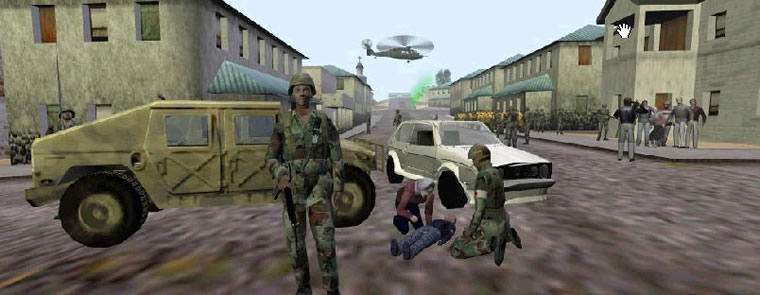| 

Inspired by Star Trek's Holodeck, Balkan Village is the
initial prototype of a holodeck-like environment created for the
Mission Rehearsal Exercise Project. The goal of the Mission Rehearsal
Exercise (MRE) Project at USC's Institute for Creative Technologies
(ICT) (see below) is to create a virtual reality training environment
for military training in scenarios like the one described here.
THE
YOUNG ARMY LIEUTENANT'S dilemma begins to unfold as his humvee
rumbles into a Balkan village. His radio crackles: “Eagle 6,
this is 1-6. The situation here is growing more serious. We’ve
spotted weapons in the crowd. How soon can we expect assistance?
Over.”
Eagle 6 is the tactical operations center. Eagle 1-6 is a platoon
at a nearby storage depot where a group of weapons inspectors are
at work. His platoon, Eagle 2-6, has an urgent mission in another
part of town, where an angry crowd surrounds a weapons inspection
team.
“Estimated ETA at your location, two-zero minutes. Over,”
responds the lieutenant. Suddenly his vehicle lurches to a stop.
Up ahead, at the rendezvous point, the lieutenant sees that another
humvee under his command has collided with a civilian car, seriously
injuring a young passenger. A soldier, the driver in the accident,
is also slightly injured. The injured boy’s mother – a
combustible mixture of fear, anger and hope – bends over her
child. She speaks to him softly in Serbian.
“Driver’s got a cracked rib, but the kid is…”
The medic hesitates, glancing at the mother. “Sir, we gotta
get a medevac in here ASAP.”
Sullen onlookers are gathering even as the lieutenant calls for
the medevac helicopter. A TV news cameraman appears and begins videotaping.
Then a helicopter roars low overhead, heading for a landing zone
farther up the street. In the distance, a rocket propelled grenade
explodes. There’s a flurry of small-arms fire.
Is the accident scene secure? The crowd is growing bigger and more
restless. What about the landing zone for the helicopter? A frantic
radio call from Eagle 1-6 reports that they are now taking fire.
Gunshots are heard over the radio. When the lieutenant orders the
platoon sergeant to dispatch a squad to secure its route to Eagle
1-6, the mother explodes. Why are the soldiers abandoning her son?
What should the lieutenant do? Does he forget about Eagle 1-6? Maybe
he can split his force and send some soldiers to reinforce the outpost?
Or should he just abandon the injured boy?
Wednesday, August 18, 1999, Los Angeles Times
Army, USC Join Forces for Virtual Research
Technology: Effort could provide more realistic military training simulations
and better Hollywood special effects
By KAREN KAPLAN, Times Staff Writer
Setting the stage for an unprecedented collaboration between the Pentagon and
Hollywood, the U.S. Army today will announce the formation of a major research
center at USC to develop core technologies that are critical to both the
military and to the entertainment industry. The US Army awarded a contract
to the University of Southern California to create the Institute For Creative
Technologies (ICT) in order to work with the entertainment and game development
industries and computer scientists to advance immersive training simulation.
The primary goal of the new Institute for Creative Technologies is to work
collaboratively with the entertainment industry to allow the Army to create
highly realistic training simulations that rely on advances in virtual reality,
artificial intelligence and other cutting-edge technologies. The entertainment
industry is expected to use the technology to improve its motion picture
special effects, make video games more realistic and create new simulation
attractions for virtual reality arcades.
"It's a marriage made in heaven," said Anita Jones, a computer science
professor at the University of Virginia who first proposed that the military
and Hollywood jointly develop key technologies in the mid-1990s when she served
as the Defense Department's director of defense research and engineering.
Paramount Simulation Uses Scripts, Technology to Test Handling
of Crisis
By JOHN LIPPMAN
THE WALL STREET JOURNAL
LOS ANGELES -- In Bosnia, cable-news correspondent Jackie Banberry
has just completed an interview in which Balkan warlord Dragon Vatroslav
issued threats against American troops. As she prepares to tape
a lead-in, machine-gun fire is heard off camera.
"What is that?" a panicked Ms. Banberry shouts, seconds
before her satellite link cuts abruptly to a test pattern.
This isn't a new international crisis. It's part of an interactive
training exercise created for the Pentagon that had its origins
in a project developed at Viacom Inc.'s Paramount Pictures. Ms.
Banberry and Mr. Vatroslav are fictional characters, the machine
gun is a sound-effect, and the whole exercise is an effort by Hollywood
to give the military a hand.
This weekend in Los Angeles, about 40 top Hollywood executives will
meet with President Bush's senior adviser, Karl Rove, to discuss
what roles Hollywood might play in the war on terrorism.
full
story
Institute for Creative
Technologies
Full
Spectrum Warrior: Full Spectrum Warrior is based on a game developed
by the ICT for the U.S. Army to train light Infantry troops in urban
combat situations, now released as a consumer product on Xbox consoles.
Jane's Combat
Simulations: a collaborative partnership between Jane's Defense
(the world's leading source for defense intelligence and information)
and Electronic Arts (the the world's leading independent games developer)
America's
Army: The Official Army Game: the controversial US army authored
video game designed as a recruitment tool
Military
Training Technology Online
Combatsim.com
|
